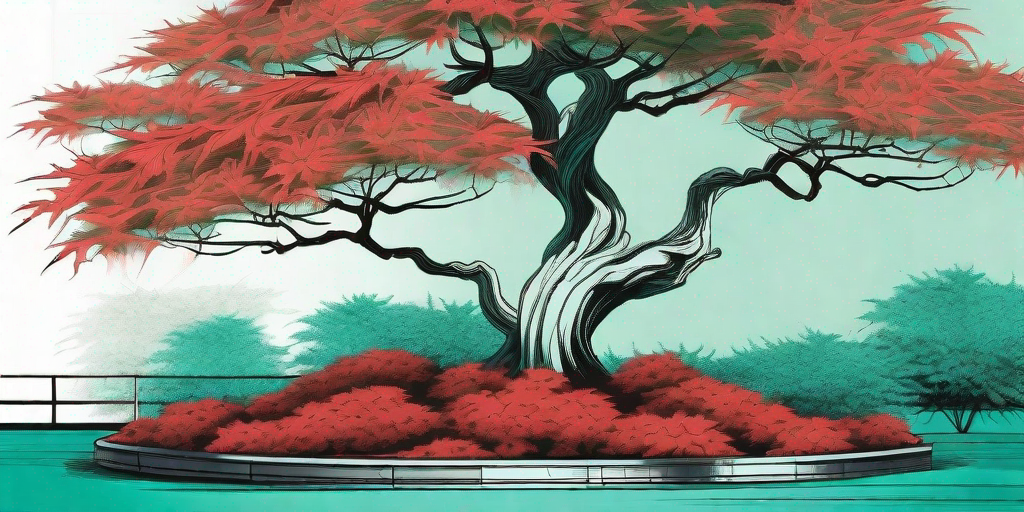
Ah, the Weeping Japanese Maple, a tree that's as dramatic as its name suggests. With its cascading branches and vibrant leaves that change with the seasons, it's no wonder this tree is a favorite among garden enthusiasts and drama queens alike. But how do you grow and care for this botanical diva? Buckle up, because we're about to embark on a horticultural journey that's as thrilling as a telenovela.
Understanding the Weeping Japanese Maple
Before we dive into the nitty-gritty of growing and caring for the Weeping Japanese Maple, it's important to understand what makes this tree so special. Also known as Acer palmatum 'Dissectum', this tree is a cultivar of the Japanese Maple, a species native to Japan, Korea, and China. Its 'weeping' moniker comes from its drooping branches, which give the tree a graceful, melancholic appearance.
But don't let its somber name fool you. The Weeping Japanese Maple is a tree that knows how to put on a show. Its leaves are a kaleidoscope of colors, ranging from green in the spring to fiery red in the fall. It's like having your very own fireworks display in your garden, minus the noise and the risk of setting your neighbor's house on fire.
Planting Your Weeping Japanese Maple
Now that we've established that the Weeping Japanese Maple is the Beyoncé of trees, let's talk about how to plant it. Like any diva, this tree has its preferences, and it's important to cater to them if you want it to thrive.
Firstly, the Weeping Japanese Maple prefers a spot with partial shade. Too much sun can cause its leaves to scorch, and nobody wants a sunburnt tree. It also prefers well-drained soil, because while it enjoys a drink, it doesn't like to have wet feet.
Step-by-Step Planting Guide
- Dig a hole that's twice as wide and just as deep as the root ball of your tree.
- Place the tree in the hole, making sure it's at the same depth as it was in its container.
- Backfill the hole with soil, firming it gently around the base of the tree.
- Water thoroughly, then mulch around the base to conserve moisture and suppress weeds.
Caring for Your Weeping Japanese Maple
Once you've planted your Weeping Japanese Maple, it's time to shower it with love and care. This involves regular watering, occasional feeding, and some light pruning to keep it looking its best.
Water your tree regularly, especially during dry spells. Remember, it likes to drink, but not to the point of waterlogging. As for feeding, a slow-release fertilizer applied in the spring should do the trick. Just remember not to overdo it, as too much fertilizer can harm your tree.
Pruning Your Weeping Japanese Maple
Pruning is like giving your tree a haircut, and like any good haircut, it should enhance your tree's natural beauty. The best time to prune your Weeping Japanese Maple is in late summer or early fall, when the tree is in dormancy.
Start by removing any dead or diseased branches. Then, trim back any branches that are crossing or rubbing against each other. Finally, shape the tree to your liking, but remember to maintain its natural weeping form. After all, you wouldn't want to turn your Weeping Japanese Maple into a Mohawk Japanese Maple.
Common Problems and How to Solve Them
Like any diva, the Weeping Japanese Maple can be a bit temperamental at times. Here are some common problems you might encounter and how to solve them.
Leaf Scorch
Leaf scorch is when the leaves of your tree turn brown at the edges and curl up, like they've been singed by a dragon. This is usually caused by too much sun or wind, or not enough water. To prevent leaf scorch, plant your tree in a sheltered spot and water it regularly.
Verticillium Wilt
Verticillium wilt is a fungal disease that can cause your tree to wilt and die. If you notice your tree looking a bit peaky, it's best to consult a tree surgeon or arborist. They can diagnose the problem and recommend a course of treatment.
Frequently Asked Questions
- How fast does a Weeping Japanese Maple grow?
Like a true diva, the Weeping Japanese Maple takes its time. It grows slowly, usually reaching its full height of 8 to 10 feet after about 10 years.
- Can I grow a Weeping Japanese Maple in a pot?
Absolutely! In fact, growing it in a pot can help you control its size and shape. Just make sure the pot is large enough to accommodate its roots and has good drainage.
- Does a Weeping Japanese Maple lose its leaves in winter?
Yes, the Weeping Japanese Maple is a deciduous tree, which means it sheds its leaves in the fall. But don't worry, it'll put on a new set in the spring.
So there you have it, a comprehensive guide to growing and caring for the Weeping Japanese Maple. With a bit of love and care, you can unleash the beauty of your garden with this stunning tree. Just remember, like any diva, it demands respect. Treat it right, and it'll reward you with a show-stopping display year after year.















